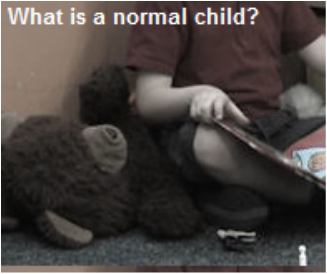 A combination of visual images, sound, and text provokes discussion. A combination of visual images, sound, and text provokes discussion.
Tags: children/youth, education, emotion/desire, psychology/social psychology, theory, philosophy, postmodernism, 11 to 20 mins
Year: 2010 Length: 16:20 Access: ESRC Summary: This unconventional and provocative film challenges viewers to reflect upon what constitutes problematic behavior in children. As described on the film's website, "it presents a thought-provoking collection of visual, sound, and text images drawn from a range of sources, including art, education, psychology, special education, policy documents, popular media, and philosophy. These materials are organized around 5 key themes: What counts as problem behavior?; What is a normal child?; Difficult Bodies; Parents; and Observing and Monitoring." The film "depart[s] from the usual didactic conventions of the educational film or the in-service training video and invit[es] a more open and critical engagement from audiences." Its organization and style reflect some of its postmodern influences (e.g. Gilles Deleuze), and have provoked interesting responses from viewers (which have been shared by the film's creators). For example, viewers have noted its highly "emotional" and "somber" tone that suggests how education "controls children"; but its open-ended nature encourages a very diverse range of responses. The film also has accompanying educational support materials, "which can be used for training and professional development purposes, [and] provides some questions to guide discussion and further activity." Submitted By: Rachel Holmes
3 Comments
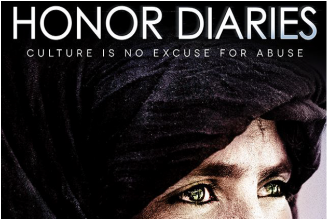 Film explores the oppression of women in honor-based societies. Film explores the oppression of women in honor-based societies.
Tags: culture, gender, inequality, social mvmts/social change/resistance, cultural relativism, gender oppression, honor-based societies, transnational feminism, 11 to 20 mins
Year: 2013 Length: 11:14 Access: YouTube Summary: This is an extended preview from the film Honor Diaries (2013), which explores the subjugation of women in honor-based societies. As explained in the clip by Ayaan Hirsi Ali, author of Infidel, “The concept of honor, it’s very difficult to explain it to Western societies. A lot of it has to do with how women behave and the sexuality of women.” Oanta Ahmed, author of In the Land of Invisible Women, elaborates saying, “Honor is something that is carried and contained in women, and is there to be guarded by men." The movie focuses on the work of nine women’s rights activists—Zainab Khan, Raheel Raza, Juliana Taimoorazy, Nazanin Afshin-Jam, Raquel Saraswati, Fahima Hashim, Nazie Eftekhari, Jasvinder Sanghera, and Manda Zand Ervin—and explores gender-based abuses including female genital mutilation, child marriages, and acid attacks. This video is useful for illustrating the concept of transnational feminist activism or, “activist efforts by feminists to change gender relations outside their own states and collaborate between and among feminists in different countries” (Wade and Ferree 2015:358). In this case, women activists from different countries (including Somalia, Saudi Arabia, Iran, Sudan, Canada, Iraq, and the UK) have come together to work against the subjugation of women in honor-based societies. The clip is also useful for inciting discussion around tensions pertaining to culturally relativist arguments about gender oppression. Western feminists have a long history of imposing their own culturally-specific perspective of feminism upon those in other societies. Aware of this imperialistic feature of Western feminisms’ history, many, including students, may resist criticizing oppressive practices taking place in non-Western societies. The activists in the clip confront this issue head-on (around the 7:50 minute mark), highlighting the resistance toward criticizing these practices for fear of being labeled an Islamaphobe. Saraswati says, "We shy away from criticizing anything that’s different because we don’t want to be seen as the type of people that would restrict someone’s expression." Westerners can learn to distinguish respectful cultural relativism from abusive oppressive practices by looking for guidance from the countless numbers of human rights activists working on these issues in their home countries. As evidenced by the women activists in this video, the notion of honor as being intricately tied to women's behaviors and bodies is justification for abuse. Submitted By: Valerie Chepp  John Oliver examines what's behind stylish cheap clothes. John Oliver examines what's behind stylish cheap clothes.
Tags: capitalism, consumption/consumerism, corporations, economic sociology, globalization, apparel, fashion, supply chains, sweatshops, 11 to 20 mins
Year: 2015 Length: 17:09 Access: YouTube Summary: In this clip from Last Week Tonight, John Oliver analyzes the rise of fast fashion and its tremendous profits. Fast fashion includes short times from design to rack, with fashion styles changing constantly at companies such as H&M, Zara, and Forever 21. But news commentators are shown marveling at the very low costs of the trendy, fashionable clothes. Given these low costs, Oliver asks “How does any clothing company make money?” After all, the industry has many billionaire founders and executives, whose companies excel with high-volume sales. The reality is that 2% of clothing worn by Americans is made in the US, while the rest is produced overseas and often in sweatshop conditions. Oliver frames this in terms of the outrage over sweatshop clothing producers in the 1990s, by companies such as Nike, Gap, and most famously, Kathie Lee Gifford. In response to protests, many of these large companies agreed to monitoring programs in their supply chains. So how have their production conditions changed? In more recent years, undercover journalists investigating Gap and Wal-Mart found child slaves; non-compliance with workplace safety standards; and repeated denial of responsibility for any wrong-doing. One particular issue is that contractors producing clothes for Wal-Mart must follow certain standards, but contractors frequently send this work to sub-contractors; when the sub-contractors violate labor standards, Wal-Mart denies any knowledge that their clothes were being produced in these factories. However, this issue is far from an isolated event, and Wal-Mart repeatedly denies awareness of these issues. This dynamic is not unique to any manufacturer, but it reflects supply chain issues that are fundamental to the global economy, and are an important part of understanding global inequality and our own participation (as consumers) within it. Submitted By: Paul Dean  Vernā Myers offers strategies for confronting implicit bias. Vernā Myers offers strategies for confronting implicit bias. Tags: inequality, prejudice/discrimination, race/ethnicity, colorblindness, implicit association, implicit bias, racism, stereotypes, 11 to 20 mins Year: 2014 Length: 17:49 Access: TEDTalks Summary: In this video diversity professional Vernā Myers links the recurrent atrocities faced by Black males in the U.S. (e.g., Michael Brown, Amadou Diallo, Sean Bell, Oscar Grant III, Trayvon Martin) to the persistence and denial of implicit biases. She highlights that while we no longer see the same blatant racially biased actions of the past, the manifestation of implicit biases contribute to the same detrimental outcomes for racial and ethnic minorities broadly and Black men specifically. She calls for the following actions to address and redress the persistence of implicit biases: 1) Get out of denial, stop trying to be “good” people, instead strive to be real people who acknowledge their personal biases; 2) Move toward young Black men (or your biases more generally) instead of away from them; 3) When we see/hear something that is wrong, we have to have the courage to say something, even to the people we love. Thus when we hear racist or bigoted statements, we need to develop the courage to speak out against such statements or actions, even if the perpetrator of the act is someone we love and care about. This video clip is a good addition to lecture topics dealing with inequality, biases, or racism. Submitted By: Shanna Brewton-Tiayon  Eri Hayward discusses her life as a trans woman Eri Hayward discusses her life as a trans woman Tags: inequality, intersectionality, lgbtq, prejudice/discrimination, religion, cisgender, mormon, trans*, transgender, subtitles/CC, 11 to 20 mins Year: 2014 Length: 14:52 Access: YouTube; Vimeo Summary: This short documentary entitled Transmormon, tracks the life of Eri Hayward, who was born and raised in Utah as a Mormon. Eri discusses how she had to come to terms with the fact that the gender she was assigned at birth was not the gender she knows herself to be. As she prepares for sex reassignment surgery, she and her parents recount her journey and how she has worked to reconcile her transgender identity with her religious beliefs as a member of the Church of Jesus Christ of Latter-day Saints. People are often hesitant to talk about what has been clearly stigmatized, so Transmormon provides an an excellent means of beginning a discussion about transgender experiences and identities. The film centers on Eri's intensely personal experiences growing up, but students can be encouraged to think about the implications of widespread stigmatization against transgender people, including the role it plays in creating high levels of violence and discrimination, higher rates of suicide, and inferior access to health care. To learn more about the public issues many transgender people face, explore our Pinterest board on the topic. Submitted By: Samuel H. Allen 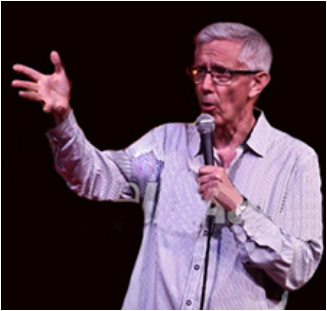 Fritz Coleman discusses the experiences of aging. Fritz Coleman discusses the experiences of aging. Tags: aging/life course, comedy, stereotypes, 11 to 20 mins Year: 2014 Length: 14:59 Access: YouTube Summary: In this video, Fritz Coleman delivers the keynote address at the Pasadena Conference on Aging. Coleman, who has been both a weatherman and standup comedian for over 30 years, shares his thoughts about aging. In a very entertaining talk, he defies a variety the stereotypes that have been attached to the aged. Coleman discusses what people go through in terms of body changes, relationship dynamics, ignored elements in a youth-oriented culture, and the subtleties of everyday life. This is a good way to introduce a sociological approach to aging that addresses the combination of biological, psychological, and social processes that affect people as they grow older. As part of a life course perspective, it emphasizes viewing older adults as active agents in their own lives, but also facing structural constraints (e.g. stereotypes), and the ways that societies view aging differently (e.g. while the US is a very youth-oriented culture, other cultures hold older adults in great esteem). As a Senior Citizen (72), I believe this will help all younger people get a better understanding of what we seniors deal with. Furthermore, it might give them a good idea of what they can look forward too. His account invites people to make sense of aging by using humor to address the physical, emotional, and mental, issues all seniors deal with. Submitted By: Paul D. LaBarre, Retired & Adjunct Faculty at Daniel Webster College and Southern New Hampshire University 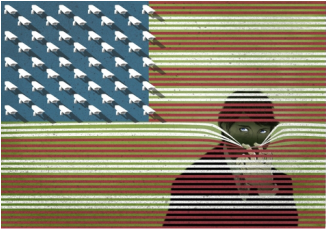 Image by Will Varner Image by Will Varner Tags: corporations, crime/law/deviance, foucault, goffman, government/the state, science/technology, theory, back stage, edward snowden, glenn greenwald, mass surveillance, n.s.a., panopticon, surveillance state, 00 to 05 mins, 11 to 20 mins, 21 to 60 mins Year: clip 1: 2013 | clip 2: 2014 Length: clip 1: 20:41 | clip 2: 5:38 Access: YouTube: clip 1: TED Talks clip 2: New York Times Summary: Taken together, the above two clips make three distinct points about why we should all take the unfolding revelations about N.S.A. surveillance very seriously, and the clips can be used to kick off a sociologically-informed discussion about the surveillance state and it's practice of mass surveillance. 1) In the first clip, journalist Glenn Greenwald delivers a TED Talk where he argues against the claim that only criminals have something to hide. People should take the N.S.A. revelations seriously because everyone has something to hide, even those of us who believe ourselves to be innocent of all crimes. After all, people routinely lock their bathroom doors and use passwords to access their email. To borrow a page from sociologist Erving Goffman, people all have a back stage. 2) In the second clip, journalist David Sirota argues we should take state surveillance seriously because the fact is, we are all criminals. That is, there are so many statutes on the books that virtually anyone could be found guilty of a crime. Chances are that even those who loudly profess they have nothing to hide have unknowingly committed crimes, and as the amount of data being collected and saved increases, the state stores aways more and more opportunities to charge any given citizen of a crime should it prove politically expedient to do so. 3) Finally, Greenwald alludes to a long standing observation in sociology that surveillance changes people; it controls them, even if charges of a crime never materialize and no formal interaction with the criminal justice system occurs. People drastically, if unknowingly, alter their behavior when they suspect they are being watched. No where is this reality more vividly illustrated than in what philosopher Jeremy Bentham described as a panopticon, a prison tower that offers a vantage point from which a guard can see all prisoners in their cells, but does not offer any single prisoner the ability to know whether he or she is being observed. Bentham imagined it as a means of controlling prisoners, but subsequent thinkers—namely Michel Foucault—have used the idea of a panopticon as a metaphor to describe the distinct way in which modern states exercise power and control. The prison tower is now the speed camera inconspicuously perched atop a traffic light; it's also the tablet that tracks it's user's browsing history. This architecture, which claims to exist for the purpose of reducing criminal behavior, is already also changing non-criminal behavior as well. Consider the journalistic practice of offering sources anonymity. As the surveillance state becomes ever more bold, the ability to promise such anonymity slips away, and some would argue, so too does an important check on government power (Note: The Sociological Cinema has explored the topic of the surveillance state here, here, and here, and we maintain a Pinterest board on the topic). Submitted By: Lester Andrist  Social and historical forces shaped the Ferguson tragedy. Social and historical forces shaped the Ferguson tragedy. Tags: crime/law/deviance, government/the state, prejudice/discrimination, race/ethnicity, violence, war/military, militarization of police, racial profiling, 11 to 20 mins Year: 2014 Length: 15:09 Access: YouTube Summary: In honor of the first week(s) of class and in response to the tragedy in Ferguson, MO, I began class by discussing "common-sense" explanations for social phenomena (naturalistic or individualistic explanations) versus sociological ones. I typically frame this activity around sociological questions such as: "Why are people poor?" or "Why do more women stay at home with children?" or "Why are people overweight?" I then present individualistic or naturalistic explanations that might be used to explain these phenomena. For instance, in the "why are people poor?" scenario, an individualistic explanation might argue that people are poor because they are are lazy, dumb, or have no skills. A sociological perspective might interrogate structures of opportunity such as education and wealth that can be used for a down payment and to help someone save money. After a couple of these scenarios, I asked students to explore the Michael Brown shooting in terms of these two approaches in order to develop their sociological imaginations. After the discussion, as a class we watched this John Oliver clip that highlights many of the systemic problems in Ferguson, MO specifically, and the U.S. generally, in order to understand the importance of context and historical forces. The clip includes discussions of the prison industrial complex, the militarization of the police force, legacies of housing discrimination, racial profiling, and much more. [Note: This post originally appeared on My Sociological Activation.] Submitted By: Michelle Smirnova 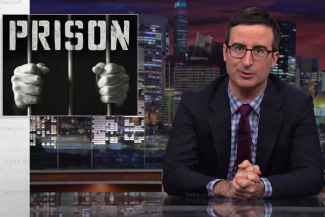 John Oliver breaks down the problems with American prisons John Oliver breaks down the problems with American prisons Tags: crime/law/deviance, inequality, political economy, prejudice/discrimination, race/ethnicity, violence, criminal justice system, incarceration, prison, prison industrial complex, racism, sexual assault, 11 to 20 mins Year: 2014 Length: 17:42 Access: YouTube Summary: In the United States, nearly 1 in every 100 adults are now in prison or jail, meaning that the U.S.incarcerates more people than those regimes Americans typically regard as repressive, such as China and Russia. Why are there so many people in American prisons? In this video from Last Week Tonight, John Oliver explains that 50% of the male prisoners in federal prisons and about 58% of female prisoners are there as a result of drug offenses. The same is true for 25.4% of all prisoners in state prisons. Given other posts on The Sociological Cinema, which explore racism in the criminal justice system (here, here and here), it may come as little surprise that a disproportionate number of prisoners are black and Latino, even when controlling for education. In fact, Human Rights Watch recently completed a study where they concluded that blacks were 10.1 times more likely to enter prison for drug offenses than whites. One result is that blacks constitute 40% of all prisoners under state jurisdiction, while whites only constitute 29% of all such prisoners. The disproportionate incarceration of blacks for drug offenses is even more striking when one considers that with the exception of crack, whites actually use more illegal drugs than blacks. The video concludes with a review of some of the deplorable conditions prisoners are now forced to endure, due in part to a move toward greater privatization. Oliver discusses the high risk of sexual assault, the small size of cells, maggot-infested food, and substandard healthcare, including an incident of pouring sugar into woman's C-section incision as a substitute for antibiotics. In another post, I have explored the fact that between 2006 and 2010, at least 148 women in California prisons were sterilized by doctors under the precepts of a eugenics ideology, a fact which underscores the desperate vulnerability of the bloated U.S. prison population. Submitted By: Lester Andrist 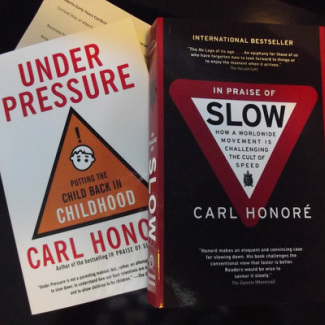 Carl Honoré encourages parents to slow down. Carl Honoré encourages parents to slow down. Tags: children/youth, class, culture, inequality, marriage/family, annette lareau, child-rearing, concerted cultivation, free range parenting, slow parenting, 11 to 20 mins Year: 2012 Length: 11:26 Access: YouTube Summary: In her book, Unequal Childhoods, Annette Lareau describes two child-rearing strategies. Concerted cultivation (where parents actively foster and assess the child’s talents, opinions, and skills) is more commonly practiced by middle-class families and the accomplishment of natural growth (where parents care for their children and allow them to grow naturally) is more typical of working class and poor families (the differences are illustrated in our previous post). While concerted cultivation is the child-rearing strategy that is more likely to instil skills and dispositions in children that enable them to succeed in the professional workplace, Lareau argues that both strategies have their advantages and disadvantages. This news clip illustrates the style of concerted cultivation, emphasizes its drawbacks, and describes a movement reacting against it. Concerted cultivation is demonstrated by children in the video who discuss strenuous daily schedules, which is motivated by parents who want their children to compete for their place in the world and excel at everything. It emphasizes the disadvantages of this child-rearing strategy with the children experiencing high levels of stress and anxiety, noting that this form of "parenting becomes a cross between a competitive sport and product development." The majority of the clip discusses Slow Parenting (also called free range parenting), a movement of parenting that reacts against these pressures. It features commentary from Carl Honoré, whose books Under Pressure and In Praise of Slow, encourage parents to slow down. He describes the strategy and its merits this way: "Slow parenting is about bringing the balance back; it's about giving children the time and space to explore the world on their own terms, at their own pace, to make mistakes and learn from them--to get bored even so that they can learn how to create ... and work out who they are rather than who we want them to be." The clip goes on to interview parents who have practiced an extreme form of this (e.g. allowing their 8-year old to travel alone on the subway) and have been criticized by people for being irresponsible. A second function of the clip is to show a cultural practice that could lessen inequality between middle-class and working-class parents. If slow parenting (which more closely resembles the accomplishment of natural growth strategy) were encouraged among middle-class families, it might help to diminish the privileges conferred upon middle-class children while improving their quality of life. Submitted By: Paul Dean |
Tags
All
.
Got any videos?
Are you finding useful videos for your classes? Do you have good videos you use in your own classes? Please consider submitting your videos here and helping us build our database!
|
 RSS Feed
RSS Feed
